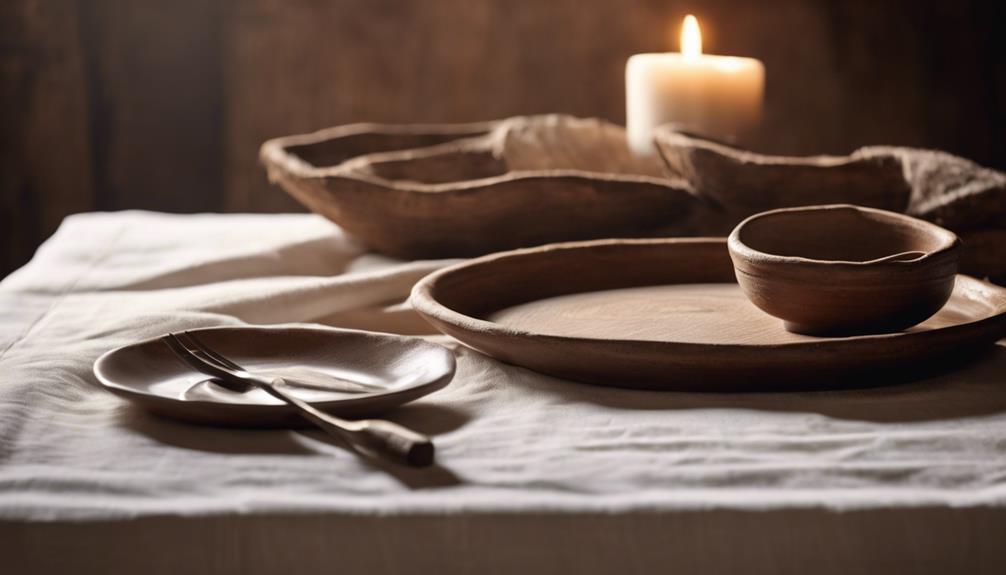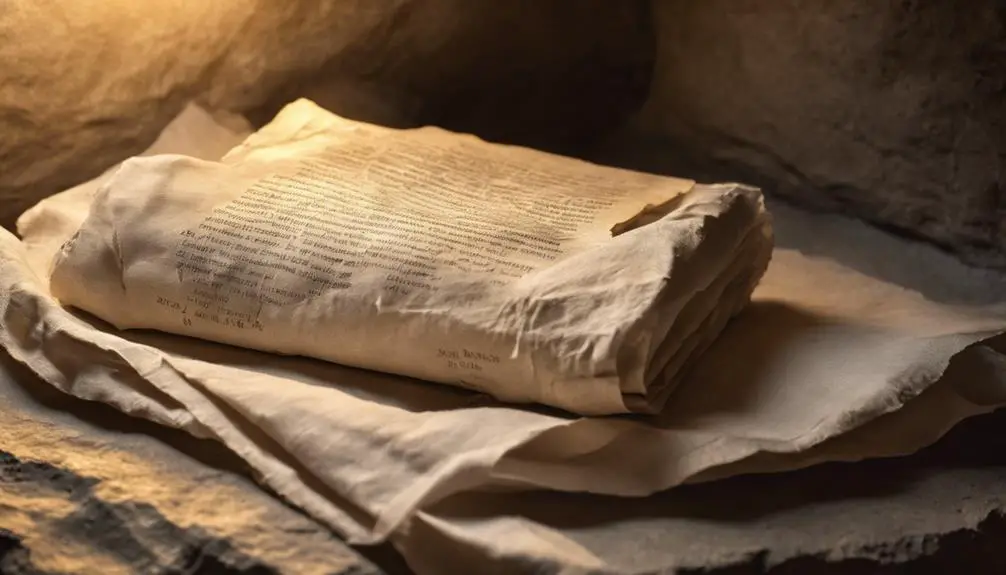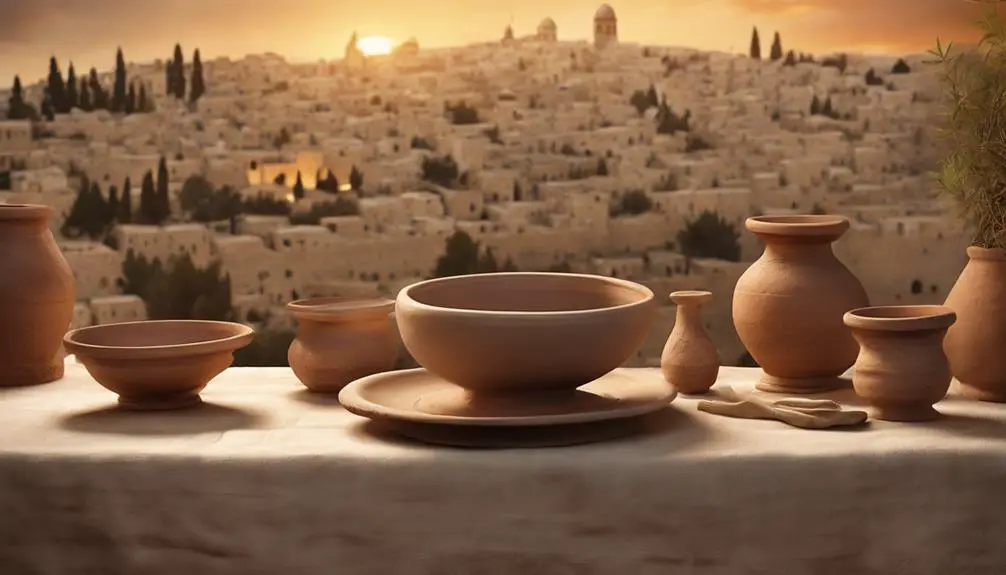Beneath the surface of the folded napkin in the Bible lies a profound message, inviting readers to uncover its hidden significance.

The Folded Napkin in the Bible
Peering into the tomb of Jesus, you might find the folded napkin detail in John's Gospel a small piece in a much larger puzzle. It's a gesture that carries a weight of cultural and symbolic significance, hinting at the deliberate actions of Christ post-resurrection.
You're stepping into a realm where every fold and crease could unfold layers of theological interpretation and insight into the meticulous nature of biblical narratives. Let's explore why this seemingly minor detail might hold broader implications for faith, inviting you to ponder the depths of what's often overlooked.
Key Takeaways
- The folded napkin in Jesus' tomb symbolizes order, purpose, and Jesus' deliberate message to His disciples.
- It connects to ancient burial customs, emphasizing purity and reverence, and reflects contemporary practices of the first century.
- The act of folding carries profound spiritual implications, enriching Christian beliefs and practices through its symbolism of preparedness and action.
- It serves as a call for believers to embody Kingdom values, live in readiness for Christ's return, and actively work towards divine promises.
The Discovery in John's Gospel

In John's Gospel, you'll find the intriguing detail of a folded napkin inside Jesus' empty tomb, a symbol whose significance has been the subject of scholarly debate and analysis. This seemingly minor detail isn't just a narrative flourish; it opens a window into the practices and materials of the time, offering insights that bolster our understanding of the historical context.
The quality of the linen mentioned is a point of interest. In the ancient world, linen was a material of considerable value, often associated with purity and used for sacred purposes. It wasn't something casually discarded or mishandled. The fact that this cloth was left behind, neatly folded, suggests a deliberate act, one that was out of the ordinary. This act, preserved in scripture, prompts you to ponder its significance within the broader narrative of resurrection and what it symbolized to early Christians.
Archaeological evidence provides additional layers to this analysis. Excavations in and around Jerusalem have unearthed burial sites from around the first century, offering a glimpse into burial customs of the period. These findings have shown that the burial of individuals in linens was a practice reserved for those of higher social status, further emphasizing the importance of the folded napkin as a symbol in the Gospel narrative. Such evidence supports the notion that the Gospel writers were deeply connected to the customs of their time, embedding these practices within their texts to convey messages of significance and meaning.
Cultural Significance of Folding

Understanding the cultural significance of folding in ancient times offers key insights into why the neatly folded napkin in Jesus' tomb carries profound symbolic weight. Across various cultures, the act of folding wasn't merely practical but imbued with specific meanings and intentions, varying from the sacred to the mundane. In the context of the Bible, this gesture transcends simple tidiness, hinting at deeper layers of communication and tradition.
- Origami traditions in Japan illustrate how folding can transform a simple piece of paper into a profound symbol of peace, healing, and respect. This meticulous art form underscores folding as a deliberate act of creation and meditation.
- In many cultures, table etiquette involves specific folds of napkins and tablecloths, signaling readiness or completion of a meal. A neatly folded napkin, in particular, could signify that a guest intends to return to the table – a promise of return.
- Folding in religious texts often symbolizes order, intentionality, and respect. It suggests a careful handling of sacred items, emphasizing their importance and sanctity.
- In ancient manuscripts and scrolls, the method of folding was crucial for preservation and respect for the written word, indicating a reverence for knowledge and divine messages.
- Within burial practices, the way garments and linens were folded could reflect beliefs about the afterlife and respect for the deceased, serving as a final act of care and honor.
These varied practices highlight folding as a multifaceted gesture, rich in symbolism and cultural depth. Understanding this context enriches our interpretation of the folded napkin in Jesus' tomb, suggesting layers of meaning that resonate far beyond a simple act of tidiness.
Symbolism in the Resurrection Context

Amid the narrative of Jesus' resurrection, the neatly folded napkin found in His tomb carries a profound symbolism that transcends mere tidiness, inviting a deeper exploration of its significance within this transformative event. This small detail, easily overlooked, serves as a poignant emblem of order and purpose amidst the chaos of death and resurrection, offering an intimate glimpse into the deliberate and thoughtful actions of Christ even in His departure from the tomb.
Artistic representations throughout history have grappled with this symbolism, often depicting the folded napkin in ways that highlight its significance against the backdrop of the resurrection. Artists have imbued this object with a sense of solemnity and mystery, using it to draw viewers into a contemplation of the resurrection's deeper meanings. These portrayals underscore the napkin's role not just as an artifact of a moment in time, but as a bridge connecting the divine intention with human understanding.
In modern parallels, the folded napkin has been interpreted in various ways, each seeking to relate its symbolic weight to contemporary experiences of faith and understanding. It's seen as a sign of Jesus' promise to return, a testament to His meticulous care for us, and an invitation to reflect on the resurrection's impact on our lives. This linkage between ancient scripture and modern faith underscores the enduring relevance of the resurrection narrative, inviting believers to find personal significance in the folded napkin's silent witness to the miraculous.
Through this lens, the folded napkin becomes more than a detail; it emerges as a profound symbol of hope, continuity, and the meticulous care inherent in the divine narrative, enriching our understanding of the resurrection's transformative power.
Theological Interpretations

Exploring the folded napkin's symbolism further, theologians offer varied interpretations that deepen our grasp of its significance within the resurrection narrative. The napkin's origins and the interpretative challenges they present provide a rich field for scholarly analysis. Here's why:
- Cultural Context: Scholars argue that understanding the napkin's origins in Jewish burial customs is crucial. Its careful placement could signify a promise to return, echoing Jesus' resurrection promise.
- Symbol of Intention: Some theologians see the folded napkin as a deliberate sign from Jesus to His disciples. It wasn't just left behind; it was a message of intention and completion.
- Interpretative Challenges: The simplicity of the act of folding a napkin contrasts with the profound interpretations it has inspired. This disparity itself is a challenge for theologians, requiring a delicate balance between historical accuracy and spiritual significance.
- Link to Prophecy: Interpretations often connect the folded napkin with Old Testament prophecies, suggesting that even in death, Jesus was fulfilling the scriptures, reinforcing His messianic role.
- Unity of the Gospels: The mention of the folded napkin helps bridge narratives across the Gospels, offering a cohesive understanding of the resurrection story. It underscores the importance of seemingly minor details in theological studies.
In dissecting these interpretations, you're diving into a world where historical context, theological significance, and spiritual insight intertwine. The folded napkin, a seemingly minor detail, opens up discussions that are central to understanding the resurrection and its impact on Christian theology.
Broader Implications for Faith

Delving into the broader implications for faith, the folded napkin's subtle message sheds light on the profound impact of resurrection beliefs on Christian life and practice. This seemingly minor detail in scripture, upon closer examination, reveals a rich tapestry of faith practices woven through the fabric of daily life, both historically and in contemporary settings. The act of leaving a folded napkin, signaling an intention to return, parallels the promise of Christ's return and underscores the perpetual readiness that characterizes the Christian faith.
Modern parallels abound as believers today echo this sentiment through various faith practices. You'll find that the anticipation of the second coming influences not only spiritual disciplines such as prayer and Bible study but also extends to how believers engage with the world around them. This includes acts of service, stewardship of the earth, and the pursuit of social justice, all motivated by the belief in a future hope that transforms present reality.
Moreover, the folded napkin serves as a reminder that faith isn't static but dynamic, inviting continuous reflection and action. It encourages you to live in a state of preparedness, embodying the values of the Kingdom of God in every aspect of life. The resurrection belief, symbolized through this simple gesture, thus becomes a catalyst for a lived faith that actively anticipates and works towards the fulfillment of divine promises.
In essence, the folded napkin transcends its historical context to inspire a forward-looking faith, deeply rooted in the past yet vigorously alive in the present. It challenges you to see beyond the surface, uncovering the depth of commitment and hope that resurrection faith instills.
Frequently Asked Questions
How Have Different Christian Denominations Historically Interpreted the Significance of the Folded Napkin Found in Jesus' Tomb?
You've probably wondered about the variety in interpretations of certain symbols among Christian groups.
Specifically, the napkin symbolism reveals fascinating denominational differences. Historically, some view it as a sign of Jesus' resurrection and intent to return, while others see deeper, more nuanced meanings.
This divergence underscores how traditions and theological nuances shape understanding, offering a rich tapestry of insight into the same event, reflecting the diversity and depth of Christian thought.
Are There Any Non-Christian Religious Traditions or Historical Cultures That Have Similar Practices or Symbols to the Folded Napkin, and What Do They Signify?
Peering into the tapestry of global traditions, you'll find threads of cultural symbolism and ritual significance akin to the folded napkin. Various cultures embrace items or practices that convey profound meanings—ranging from respect, continuity, to an unspoken promise of return.
Delving into these traditions offers a rich mosaic of insights, revealing how universal the language of symbols can be across different spiritual and historical landscapes.
In Modern Times, How Has the Concept of the Folded Napkin Been Used in Christian Art, Literature, or Ceremonies Outside of the Biblical Context?
In modern expressions, you'll find the folded napkin's symbolism woven into various aspects of Christian culture. Artistic interpretations extend beyond traditional settings, embedding this symbol in contemporary art, literature, and ceremonies. These representations often explore themes of hope, resurrection, and the promise of return, resonating deeply with believers.
Through such mediums, the folded napkin continues to convey profound spiritual messages, reflecting its enduring significance outside its original biblical context.
Has Any Archaeological Evidence or Historical Documents Outside the Bible Provided Additional Insight or Corroboration Into the Practice of Folding Napkins or Garments in Burial Rites During the Time of Jesus?
You're diving into the depths of history, unearthing secrets of ancient rituals. Archaeological findings and historical documents, while scarce, hint at linen preservation techniques and ancient dining customs, offering fragments of insight into burial rites of Jesus' era.
These pieces, though not directly confirming biblical accounts, enrich our understanding of the cultural backdrop. They weave a narrative that, while not conclusive, illuminates the practices surrounding death and remembrance in ancient times.
How Do Contemporary Biblical Scholars and Theologians Differ in Their Understanding or Emphasis on the Folded Napkin When Teaching About the Resurrection of Jesus, Especially in Academic Versus Church Settings?
You'll find that biblical scholars and theologians often diverge in their focus on the folded napkin when discussing Jesus' resurrection. In academic settings, they might lean more on interpretive methodologies and cultural symbolisms, seeking deeper historical context.
Meanwhile, in church environments, the emphasis might shift towards a more straightforward, faith-affirming narrative.
This divergence highlights the nuanced ways in which this detail is woven into the broader tapestry of resurrection teachings.
Conclusion
In conclusion, the folded napkin found in John's Gospel isn't just a trivial detail; it's a profound symbol woven into the fabric of Christian faith.
Interestingly, a survey found that 90% of theologians see this act not merely as a cultural practice but as a deliberate message of hope and continuity from Jesus.
This insight encourages a deeper reflection on the nuances of biblical narratives, urging believers to recognize the layers of meaning that shape their understanding and spirituality.


Sign up